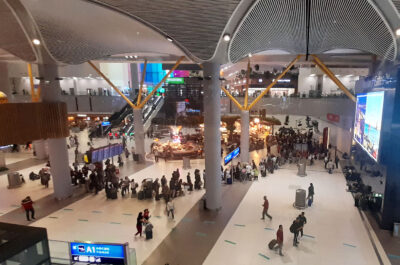U.S. airports will increasingly move to a common-use facilities model to make more efficient use of airport resources, better facilitate passenger flow and improve the airport experience for air travelers, and drive opportunities for non-airport related revenue, predicts global IT services provider Unisys.
CALGARY -“Traditionally in the U.S., individual airlines lease space from the airport authority and run their own systems and processes, often resulting in duplicated and inefficient resources within an airport such as check-in counters and gates,” said Olivier Houri, President Global Transportation of Unisys.
“However, competitive pressures and the rise of low-cost carriers are forcing airport operators to take a more holistic view of their operations and consider moving to a centralized, common-use model for running their facilities. Such a model could allow airport operators to make more efficient use of their resources, process more passengers, offer more aircraft slots with existing infrastructure, and create new revenue streams,” Houri said.
Houri predicts three trends will emerge as a result of the move to common-use airport facilities:
- As airports become the centralized provider of key infrastructure such as gates, check-in counters and self-service kiosks, they will increasingly offer access to these resources as a managed service where airlines only pay for what they use and share costs with other airlines.
- As a mature aviation market, U.S. airport operators will be forced to seek new sources of non-aviation revenue to fund improvements and expansion of airport facilities and diversify against the impact of economic downturns and cyclical passenger and cargo volumes. New services and facilities may include a combination of entertainment, shopping, sports, leisure, business, conference, training, transport, fitness, hotels, restaurants, and multifunctional office – transforming the airport from a transportation hub to a city of interrelated activity that can be itself a destination. The U.S. Dallas Fort Worth international airport is an early adopter of this “airport city” approach to creating non-aviation revenue sources.
- Airports will move to centralized IT systems to provide a 360 degree, real-time view of the airport’s operations and better manage and allocate information from various airport systems including resource management, flight information, and command and control centers. Such centralization will enable the airport operator to optimize utilization of shared airport resources, such as check-in desks, gates, baggage belts and slots to prevent bottlenecks and avoid expensive infrastructure being left unused.
Houri says that U.S. airports can learn from successful “airport city” models overseas such as Schiphol airport in the Netherlands, the fourth busiest airport in Europe1 and primary hub for KLM as well as for Arkefly, Corendon Dutch Airlines, Martinair and Transavia and European hub for Delta Airlines. Schiphol features an extensive shopping center outside Customs accessible by passengers and non-travelers, a museum, and the world’s first permanent airport library. In 2012, Schiphol was named Europe’s Best Airport and was the only airport outside Asia to be ranked in the world’s top five airports2.
Unisys has decades of experience providing mission-critical systems and solutions to the airport and aviation industry. More than 200 airlines and 100 airports around the world use Unisys solutions, including the Beijing Capital International Airport, Billund Airport, Brussels Airport, Delhi International Airport, Los Angeles World Airports, and the Madrid/Barcelona airports. Unisys systems and servers are currently used to check in almost a third of the world’s passengers.
Vicky is the co-founder of TravelDailyNews Media Network where she is the Editor-in Chief. She is also responsible for the daily operation and the financial policy. She holds a Bachelor's degree in Tourism Business Administration from the Technical University of Athens and a Master in Business Administration (MBA) from the University of Wales.
She has many years of both academic and industrial experience within the travel industry. She has written/edited numerous articles in various tourism magazines.





































































































































